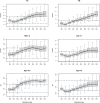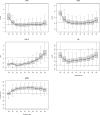Consecutive reference intervals for biochemical indices related to serum lipid levels and renal function during normal pregnancy
- PMID: 35971117
- PMCID: PMC9377122
- DOI: 10.1186/s12884-022-04960-0
Consecutive reference intervals for biochemical indices related to serum lipid levels and renal function during normal pregnancy
Abstract
Background: Physiological changes that occur during pregnancy can influence serum lipid levels and laboratory tests for renal function. Therefore, we established consecutive and reliable RIs for serum lipid and renal function indices for pregnant women in China throughout the entirety of pregnancy.
Methods: We included 120 healthy pregnant women who underwent a naturally conceived and uncomplicated pregnancy and delivered a healthy singleton neonate. Serum samples were collected at ten time points (pre-pregnancy, gestational age ≤ 8 weeks (W), 8 W+1 to 12 W, 12 W+1 to 16 W, 16 W+1 to 20 W, 20 W+1 to 24 W, 24 W+1 to 28 W, 28 W+1 to 32 W, 32 W+1 to 36 W, and 36 W+1 to 40 W) and analyzed for ten common serum lipid and renal function analytes. RIs were calculated according to the International Federation of Clinical Chemistry and Laboratory Medicine recommendations and compared with the established RIs for healthy adult women.
Results: During pregnancy, we observed significant increases in total cholesterol (TC), triglycerides (TG), high density lipoprotein cholesterol (HDL-C), low density lipoprotein cholesterol (LDL-C), apolipoprotein-A1 (Apo-A1), apolipoprotein-B (Apo-B), cystatin C (Cys-C), and estimated glomerular filtration rate (eGFR). We also observed clear reductions in urea, creatinine (Crea), and uric acid (UA). Compared with the previously established RIs, the most significant misclassifications were recorded for TG, Apo-A1, Crea, and eGFR.
Conclusions: We successfully described key changes in serum lipid levels and renal function indices throughout pregnancy. It is important to establish RIs for blood indices in women undergoing normal pregnancies during different period of pregnancy to avoid the misdiagnosis of disease states.
Keywords: Biochemical indices; Pregnancy; Reference interval; Renal function; Serum lipid.
© 2022. The Author(s).
Conflict of interest statement
The authors declare that they have no competing interests.
Figures



References
-
- Friis PJ, Friis-Hansen LJ, Jensen AK, Nyboe AA, Lokkegaard E. Early pregnancy reference intervals; 29 serum analytes from 4 to 12 weeks' gestation in naturally conceived and uncomplicated pregnancies resulting in live births. Clin Chem Lab Med. 2019;57(12):1956–1967. doi: 10.1515/cclm-2019-0495. - DOI - PubMed
MeSH terms
Substances
Grants and funding
LinkOut - more resources
Full Text Sources
Medical
Research Materials
Miscellaneous

